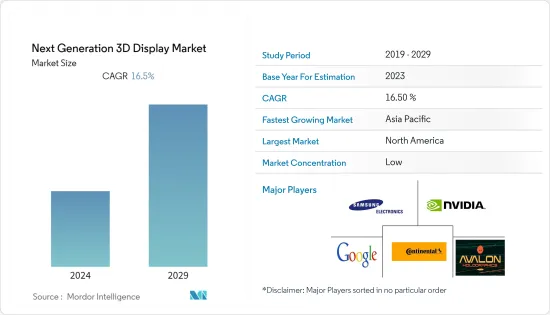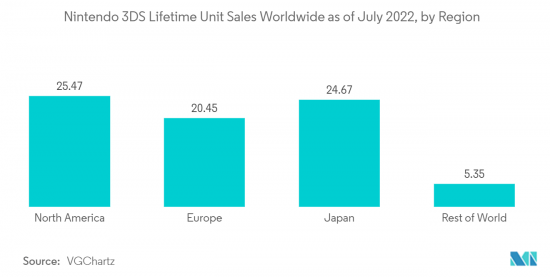 |
市场调查报告书
商品编码
1406121
下一代 3D 显示 -市场占有率分析、行业趋势/统计、2024 年至 2029 年成长预测Next Generation 3D Display - Market Share Analysis, Industry Trends & Statistics, Growth Forecasts 2024 - 2029 |
||||||
※ 本网页内容可能与最新版本有所差异。详细情况请与我们联繫。
下一代3D显示器市场上年度估值为982.2亿美元,预计未来五年将以16.5%的复合年增长率成长至5,722.5亿美元。
此外,三星电子、英伟达和微软等大多数公司专注于开发多用户显示器,特别是采用屈光光学方法,也推动了市场成长。

主要亮点
- 面板製造的持续开拓、8K 电视的推出以及对视觉舒适度的日益重视是推动市场成长的一些因素。全球智慧电视的使用量不断增加正在推动市场成长。根据 Ofcom 的数据,去年 67% 的英国家庭拥有智慧型电视。
- 一些公司已经将裸眼 3D 技术融入其产品中,以获得市场竞争优势。例如,2023 年 3 月,中国科技公司中兴发布了最新创新产品 Nubia pad 3D,可提供裸眼 3D 视觉效果。这款平板电脑配备 12.4 吋 LCD 萤幕,原始解析度为 2560x1600px,刷新率为 120Hz,长宽比为 16:10。此外,宏碁、华硕等品牌已经发表了配备裸眼3D技术的笔记型电脑。
- 此外,作为工业自动化的一部分,5G 在工业中的日益普及也有助于连网型生态系统的发展,其中 3D 显示智慧型手机和电脑发挥关键作用。根据HMS Networks预测,2021年工业自动化网路市场将成长6%,工厂热切期盼5G无线。
- 电脑游戏已成为千禧世代游戏玩家的热门选择。这种变化主要是由于多种因素造成的,包括游戏品质、高端软体和硬体的可得性以及网路频宽的改进。现在出现了更令人兴奋和要求更高的新技术,例如 VR 和 3D 显示器。因此,PC游戏玩家预计会相应升级他们的设备,这是推动专用游戏PC和游戏萤幕等配件销售的因素之一。
- 此外,3D显示设备的高组装成本也限制了市场的成长。由于这一步骤涉及新技术的生产和建设,因此对中小企业来说可能会造成经济负担。此外,对于低度开发国家的消费者来说,价格可能显得昂贵,限制了市场扩张。
- 在新冠疫情第一阶段,由于消费者对产品的支出延迟,对智慧型手机、电视和类似配套家电的需求下降,从而影响了3·19显示器市场。同时,随着网路培训和在家工作的限制解除,对家用电器的需求增长。
下一代3D显示市场趋势
家电提供成长机会
- 随着VR的积极发展,AR(扩增实境)也逐渐兴起。与基于双眼和光场显示的VR/AR类比,预测基于全像显示的VR/AR技术的未来,为消费电子产业的下一代3D显示器创造成长机会。例如,2023 年 6 月,苹果宣布推出首款混合实境头戴装置 Vision Pro。这款耳机主要定位为扩增实境设备,但您可以使用转盘轻鬆在 AR 和 VR 之间切换。
- 由于技术不断进步,下一代3D显示市场的消费性电子领域预计将实现高速成长。
- 此外,由于越来越多地安装在显示器、电视、智慧型手机、数位相框和笔记型电脑等各种家用电器中,预计该市场在预测期内将稳定成长。消费性电子产品中的无玻璃 3D 显示器允许观看者调整影像的观看深度,从而更好地控制自己的观看体验。
- 爱立信预计,到 2026 年,全球智慧型手机用户量预计将达到 75.16 亿支。因此,随着高阶智慧型手机变得越来越普及,智慧型手机製造商正在引入先进的智慧型手机功能,以区别于竞争对手,这有助于市场成长,并且在研究期间预计这一趋势将持续下去。
- 此外,一些主要製造商正在专注于新产品开发,以满足不断增长的需求。例如,2023 年 4 月,Sony Corporation发布了一款新型 3D 显示器 ELF-SR2。此显示器显示观看者无需特殊眼镜即可看到的立体影像。

亚太地区将实现市场最大成长
- 由于存在台湾等在家用电子电器领域取得长足进步的新兴经济体和国家,亚太地区对于全像显示市场来说是一个非常有利的市场。台湾、中国、韩国。儘管印度市场正处于非常发展的阶段,但在零售业支持的新兴经济体、广告支出增加以及公共和私人基础设施改善的推动下,对下一代显示器的需求预计将在预测期内增长。 。
- 几家领先公司正致力于为该地区带来新技术和先进技术,进一步推动市场成长。例如,2022 年 4 月,印度行销传播集团 Laqshya Media Group 宣布将为印度 Tanishq 的 Season of Bloom 系列《Live a Dream》带来身临其境型3D 显示器。该显示器将安装在孟买班德拉的 Bandstand Promenade。这个 3D 装置是一个梦幻般的梦幻世界体验,将优雅、复杂和艺术性的组合带入生活。
- 此外,2023年5月,全球智慧型手机品牌摩托罗拉宣布将在印度发布一款配备3D曲面显示器的新智慧型手机「Edge 40」。这款新型智慧型手机完美融合了最尖端科技、无可挑剔的设计和满足不断变化的消费者需求的软体体验。每家公司的这些推出预计将支持市场成长。
- 此外,由于消费性电子产品製造能力不断扩大,对邻近东南亚国家的出口增加,以及各种显示技术(如4K、LCD、LED、和OLED,预计将在中南部地区成长。
- 该地区比其他地区更具竞争力,因为任天堂等大多数主要供应商都位于该地区。
下一代3D显示产业概况
由于大量公司的存在,下一代 3D 显示市场高度分散。主要企业专注于技术进步,采取了收购、联盟、合资等多种策略。
- 2023 年 2 月 - 大陆集团宣布将透过 5K 自然 3D 显示器扩展其 3D 显示器解决方案产品组合,这是一种可实现三维沉浸式用户体验的创新显示解决方案。此显示器采用矩阵背光,配备 3,000 个 LED,可提供具有高对比度的卓越影像质量,同时还有助于节省功耗并提高可读性。
- 2023 年 1 月 - 三星电子宣布推出全新 Neo QLED、MICRO LED 和三星 OLED 系列,以及生活风格产品和配件。三星的 3D 地图视图让消费者能够一目了然地看到家中和 SmartThings 装置中的所有内容。
其他福利:
- Excel 格式的市场预测 (ME) 表
- 3 个月分析师支持
目录
第一章简介
- 研究假设和市场定义
- 调查范围
第二章调查方法
第三章执行摘要
第四章市场洞察
- 市场概况
- 产业价值链分析
- 产业吸引力-波特五力分析
- 供应商的议价能力
- 消费者议价能力
- 新进入者的威胁
- 替代品的威胁
- 竞争公司之间的敌对关係
第五章市场动态
- 市场驱动因素
- 汽车和家电市场的扩大成长
- 数位相框和头戴式显示器的采用率增加
- 市场抑制因素
- 缺乏3D内容的开发
- 昂贵的 3D 显示器
- 评估 COVID-19 对产业的影响
第六章市场区隔
- 产品
- 3D全息显示
- 头戴式显示器 (HMD)
- 静态音量显示
- 立体
- 扫频音量显示
- 音量显示
- 科技
- 数位光处理背投电视(DLP RPTV)
- 发光二极体(LED)
- 有机发光二极体二极体(OLED)
- 等离子显示面板 (PDP)
- 液晶显示器(LCD)
- 存取方式
- 微显示
- 传统/基于萤幕的显示
- 最终用户产业
- 消费性电子产品
- 汽车/交通
- 医疗保健
- 航太/国防
- 产业
- 其他的
- 地区
- 北美洲
- 欧洲
- 亚太地区
- 拉丁美洲
- 中东/非洲
第七章 竞争形势
- 公司简介
- Avalon Holographics Inc.
- Avegant Corp.
- Robert Bosch GmbH
- Continental AG
- Fovi 3D
- Samsung Electronics
- Nvidia
- Coretronic Corporation
- Creal 3D
- SHARP Corporation
- LG Electronics
- AU Optronics Corp.
- Panasonic Corporation
第八章投资分析
第九章 市场机会及未来趋势

The next-generation 3D display market was valued at 98.22 billion in the previous year and is expected to grow at a CAGR of 16.5 % during the forecast period to become USD 572.25 billion by the next five years. The emphasis on developing multi-user displays and, in particular, using the refractive optics approach by the majority of companies, such as Samsung Electronics, Nvidia, Microsoft, etc., is also boosting the growth of the market.
Key Highlights
- The continuous development in panel manufacturing, the introduction of 8K television, and the increasing emphasis on visual comfort are some of the factors driving the growth of the market. The increase in smart TV use throughout the globe drives market growth. According to Ofcom, in the last year, 67% of homes in the UK owned a Smart TV.
- For the purpose of gaining an competitive advantage on the market, some companies have already incorporated glassless 3D into their products. For instance, in March 2023, ZTE, a China-based tech company, announced introducing of its latest innovation, the Nubia pad 3D, which offers glass-free 3D visuals. This tablet features a 12.4-inch LCD screen with a native resolution of 2560x1600px with a 120Hz refresh rate and 16:10 aspect ratio. Furthermore, brands like Acer and Asus have already announced laptops with glass-less 3D technology.
- Moreover, the growth in the 5G deployment in industries as part of industrial automation also contributes to developing a connected ecosystem where 3D-displayed smartphones and computers play a vital role. According to HMS Networks, the industrial automation networking market grew by 6% in 2021, with wireless waiting for 5G in factories.
- PC gaming has become a favorite choice among millennial gaming enthusiasts. This shift is primarily due to multiple factors, such as the quality of gameplay, availability of high-end software and hardware, and improved internet bandwidth. Newer exciting, and demanding technology, such as VR and 3D displays, are available today. As a result, PC gamers are expected to upgrade their equipment accordingly, which is also one of the reasons for helping to drive the sales of gaming-specific PCs and accessories such as gaming screens.
- Moreover, the high cost of assembling 3D display devices is restraining the market growth. The procedure entails the production and construction of novel technologies, which could prove to be financially burdensome for smaller enterprises. Moreover, the pricing may appear expensive for consumers in less developed countries, constraining the expansion of the market.
- Demand for smartphones, televisions and similar ancillary consumer electronics declined during the first phase of COVID as a consequence of consumers' delays in spending on products which had affected the 3 19 display market. Demand for consumer electronics products, on the other hand, had grown following the lifting of restrictions as a result of Internet training and working from home.
Next Generation 3D Display Market Trends
Consumer Electronics to Provide Growth Opportunities
- With the vigorous development of VR, augmented reality (AR) is also gradually emerging. The future of VR/AR technology based on holographic display is predicted by analogy with the VR/AR based on binocular vision display and light field display, thus creating growth opportunities for next-generation 3D display in the consumer electronics industry. For instance, in June 2023, Apple Inc. announced the introduction of its first-ever mixed-reality headset, ' Vision Pro.' The headset is primarily positioned as an Augmented Reality device but switches between AR and VR effortlessly using a dial.
- The consumer electronics segment in the next-generation 3D display market will witness high growth due to rising technological advancement, and the industry stands to gain significantly if glassless 3D technology gains wider acceptance.
- In addition, the market will grow steadily over the forecast period due to an increasing uptake of these screens in various consumer electronic devices such as monitors, TVs, smartphones, digital photo frames and notebook computers. The glassless 3D display in consumer electronics allows viewers to adjust the image's viewing depth, giving them greater control over their viewing experience.
- According to Ericsson, worldwide smartphone subscription is expected to reach 7,516.0 million units by 2026. Thus, the increasing adoption of high-end smartphones has led smartphone manufacturers to introduce advanced smartphone features to stay ahead of the competitors, which in turn has contributed to the market growth and is expected to do so over the study period.
- Furthermore, several leading manufacturers are focusing on developing new products to meet the growing demand. For instance, in April 2023, Sony Corporation announced to introduce new 3D display, the ELF-SR2, which displays a stereoscopic image where viewers can see without needing special glasses.

Asia Pacific to Witness Largest Growth in The Market
- Asia Pacific presents a very lucrative market for the holographic display market owing to the presence of developing economies as well as Countries like Taiwan have made great strides in the area of consumer electronics. Taiwan, China, , and South Korea. While the market in India is at a very nascent stage, however with a developing economy buoyed by a retail sector, increasing advertising expenditures, and improving public and private infrastructure in India, the demand for next-generation displays is expected to grow over the forecast period.
- Several leading players are focusing on bringing new and advanced technologies to the region, further supporting the market growth. For instance, in April 2022, Laqshya Media Group, a marketing communication group in India, announced to bring the immersive 3D display to India for Tanishq's season of bloom collection, Live a Dream. The display is installed at Bandstand Promenade, Bandra, in Mumbai. This 3D installation is a senatorial experience of fantastical realm of dreams and brings to life the elegance, complexity, and artistry of the assortment.
- Moreover, in May 2023, Motorola, a global smartphone brand, announced to launch of a new smartphone, "Edge 40," with a 3D curved display in India. The new smartphone is the perfect blend of cutting-edge technology, impeccable design, and software experiences that cater to the ever-evolving demands of consumers. Such introduction by the players will support the market growth.
- Further, the expansion of consumer electronics manufacturing capacities, The adoption of holographic displays is projected to grow especially in China's South Central Region due to the increasing exports into neighbouring Southeast Asian countries and lower average selling prices for various display technologies such as 4K, LCD, LED or OLED. among the different 3D display devices in the region.
- The easy availability of 3D gaming hardware and software in the region will boost the growth opportunities for next-generation 3D displays, as most of the prime vendors like Nintendo are based in the region, providing the region with a competitive edge over others.
Next Generation 3D Display Industry Overview
The next generation 3D display market is highly fragmented because of the presence of large number of players in the market. The major market players are focusing on technological advancements and the players are adopting different strategies namely acquisitions, partnerships, joint ventures, by which only top players are gaining the market share.
- February 2023- Continental AG announced to expand its 3D display solutions portfolio with 5K natural 3D display, an innovative display solution for a three-dimensional and immersive user experience. The display is illuminated through a matrix backlight with 3,000 LEDs, which results in excellent picture quality with high contrast, further helping to save power and improve readability.
- January 2023- Samsung Electronics announced to introduce its new Neo QLED, MICRO LED, and Samsung OLED lineups alongside lifestyle products and accessories. It features a 3D map view, designed for users to conveniently control and monitor connected devices; Samsung's 3D Map View provides users a bird's eye view of consumers' homes and all of their SmartThings devices at-a-glance.
Additional Benefits:
- The market estimate (ME) sheet in Excel format
- 3 months of analyst support
TABLE OF CONTENTS
1 INTRODUCTION
- 1.1 Study Assumptions and Market Definition
- 1.2 Scope of the Study
2 RESEARCH METHODOLOGY
3 EXECUTIVE SUMMARY
4 MARKET INSIGHTS
- 4.1 Market Overview
- 4.2 Industry Value Chain Analysis
- 4.3 Industry Attractiveness - Porter's Five Forces Analysis
- 4.3.1 Bargaining Power of Suppliers
- 4.3.2 Bargaining Power of Consumers
- 4.3.3 Threat of New Entrants
- 4.3.4 Threat of Substitutes
- 4.3.5 Intensity of Competitive Rivalry
5 MARKET DYNAMICS
- 5.1 Market Drivers
- 5.1.1 Increasing Growth of Automotive and Consumer Electronics Market
- 5.1.2 Rising Adoption of Digital Photo Frames and Head-mount Displays
- 5.2 Market Restraints
- 5.2.1 Lack of 3D Content Development
- 5.2.2 Cost-Intensive 3D Displays
- 5.3 Assessment of Impact of COVID-19 on the Industry
6 MARKET SEGMENTATION
- 6.1 Product
- 6.1.1 3D Holographic Display
- 6.1.2 Head Mounted Displays (HMD)
- 6.1.3 Static Volume Displays
- 6.1.4 Stereoscopy
- 6.1.5 Swept Volume Displays
- 6.1.6 Volumetric Displays
- 6.2 Technology
- 6.2.1 Digital Light Processing Rear-Projection Television (DLP RPTV)
- 6.2.2 Light Emitting Diode (LED)
- 6.2.3 Organic Light Emitting Diode (OLED)
- 6.2.4 Plasma Display Panel (PDP)
- 6.2.5 Liquid Crystal Display (LCD)
- 6.3 Access Method
- 6.3.1 Micro Display
- 6.3.2 Conventional/Screen Based Display
- 6.4 End User Industry
- 6.4.1 Consumer Electronics
- 6.4.2 Automotive and Transportation
- 6.4.3 Medical
- 6.4.4 Aerospace & Defense
- 6.4.5 Industrial
- 6.4.6 Others
- 6.5 Geography
- 6.5.1 North America
- 6.5.2 Europe
- 6.5.3 Asia Pacific
- 6.5.4 Latin America
- 6.5.5 Middle East and Africa
7 COMPETITIVE LANDSCAPE
- 7.1 Company Profiles
- 7.1.1 Avalon Holographics Inc.
- 7.1.2 Avegant Corp.
- 7.1.3 Robert Bosch GmbH
- 7.1.4 Continental AG
- 7.1.5 Fovi 3D
- 7.1.6 Samsung Electronics
- 7.1.7 Nvidia
- 7.1.8 Google
- 7.1.9 Coretronic Corporation
- 7.1.10 Creal 3D
- 7.1.11 SHARP Corporation
- 7.1.12 LG Electronics
- 7.1.13 AU Optronics Corp.
- 7.1.14 Panasonic Corporation













